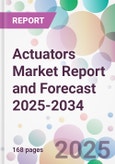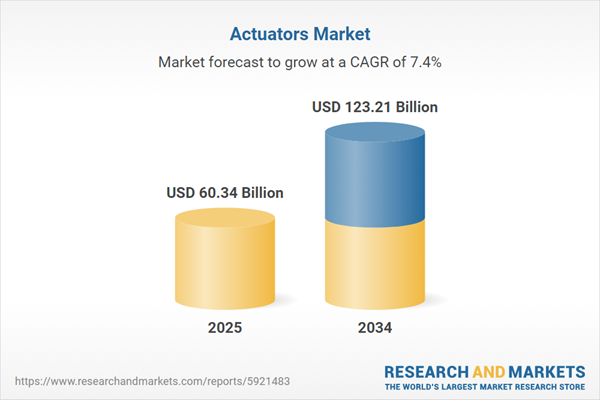An actuator refers to a component of the machine, which ensures mobility and control over a mechanism or system. They are fundamental parts of systems and devices across a wide range of industrial sectors, including automotive, manufacturing, and robotics. For instance, the opening up of a valve which requires a source of energy and a control signal from actuators.
The creation of advanced and price-effective actuators, along with the rising demand for robotics and process automation in various industrial segments, are some of the factors that affect the actuators market growth. As companies look to improve efficiency, reduce labour costs, and enhance precision, the role of actuators becomes more critical in enabling these technologies. The integration of smart technologies and the Internet of Things (IoT) into actuators allows for real-time monitoring, control, and diagnostics, leading to more efficient and reliable operations. This trend towards smarter, more connected systems drives the development of advanced actuators.
Key Trends and Developments
Increased adoption of electric actuators; rising trend of miniaturisation; expansion of actuators in the renewable energy sector; and regulatory and environmental compliance are the major trends impacting the actuators market expansionActuators Market Trends
The trend towards the miniaturisation of actuators is a significant development in the market, driven by the need for smaller, more efficient, and highly precise motion control solutions across various applications. The healthcare sector's push for minimally invasive surgeries and more compact, portable medical devices requires actuators that can operate in limited spaces with high precision. Miniaturised actuators enable the development of sophisticated medical instruments, implants, and diagnostic equipment.As consumer electronics like smartphones, cameras, and wearables become smaller and more feature-packed, there is a demand for actuators that can perform tasks in very compact spaces and further contribute to the trend of miniturisation in actuators market.
The leading market players are focusing on launching improved product range that can deliver remarkable performance. In December 2023, Flowserve Corporation, recognised globally for providing flow control solutions and services tailored for infrastructure markets, introduced a cutting-edge development in their product line - the Limitorque QX Series B (QXb). This new offering represents a significant advancement in actuator technology, specifically designed for quarter-turn applications, which are movements typically required for valves that rotate through 90 degrees to open or close.
Market Segmentation
“Actuators Market Report and Forecast 2025-2034” offers a detailed analysis of the market based on the following segments:Market Breakup by Actuation
- Electrical
- Hydraulic
- Pneumatic
- Others
Market Breakup by Type
- Linear Actuators
- Rotary Actuators
Market Breakup by Application
- Industrial Automation
- Robotics
- Vehicles and Equipment
- Others
Market Breakup by Region
- North America
- Europe
- Asia-Pacific
- Latin America
- Middle East and Africa
Linear actuators account for a significant actuators market share owing to its growing usage for automation
In the forecast period, the linear segment is expected to grow at the highest CAGR. The linear actuators are primarily used in automation applications as well as other industrial sectors, where positioning is required. The healthcare sector's expanding reliance on advanced medical devices and equipment, such as adjustable beds, surgical tools, and diagnostic machines, also drives the demand for linear actuators as these applications often require high precision, reliability, and cleanliness, characteristics that linear actuators can provide.
Rotary actuators, devices that generate rotational motion, are essential components in various applications across multiple end-use sectors. The widespread push towards automation in manufacturing and industrial sectors significantly drives the demand for rotary actuators as these devices are crucial for machinery requiring precise rotational movement, such as conveyors, mixers, and robotic arms, facilitating efficient and automated processes. In the automotive sector, rotary actuators are used for numerous applications, including steering mechanisms, valve controls, and throttle systems.
Industrial automation maintains its dominance in the actuators market due to growing applications in diverse sectors
Industrial automation holds the major share of the market. The demand for actuators in industrial automation is driven by a wide range of applications across various manufacturing sectors, including automotive, electronics, food and beverage, pharmaceuticals, and more. Actuators are critical components in automated machinery, production lines, and control systems, facilitating the move towards more efficient, precise, and reliable manufacturing processes.
The actuators market growth is also driven by its applications in vehicles and equipment as the automotive sector, including both conventional and electric vehicles, relies heavily on actuators for numerous applications, such as braking systems, throttle control, steering mechanisms, and automated driving systems. Additionally, the broader vehicles and equipment category encompasses heavy machinery, aerospace, and marine vessels, all of which utilise actuators for various functions.
Competitive Landscape
The market players are introducing novel products as well as focusing on mergers and acquisitions to gain a competitive edge in the marketOther major players in the actuators market are IMI Critical Engineering, Tolomatic, Inc., and Venture MFG. Co., among others. These companies cater to various industrial sectors including automotive, aerospace, defence, industrial automation, healthcare, and consumer electronics.
Actuators Market Analysis by Region
North America holds a major share of the market. The region has a substantial manufacturing sector that is increasingly moving towards automation to enhance productivity, efficiency, and safety. Industrial sectors such as automotive, aerospace, food and beverage, and pharmaceuticals are integrating more automated systems that rely on actuators for precise control and movement, fueling the demand for these components. With the rise of electric vehicles (EVs) and autonomous vehicles, there is an increased need for various types of actuators, including those for electric braking systems, adaptive suspension, and automated driving assistance systems.Meanwhile, the Asia-Pacific is a global manufacturing hub, with countries like China and India leading in various manufacturing sectors, including electronics, automotive, textiles, and machinery. The push towards automation to enhance production efficiency and product quality is driving the demand for efficient systems in industrial applications, boosting the actuators market growth.
Table of Contents
Companies Mentioned
The key companies featured in this Actuators market report include:- Rockwell Automation, Inc.
- Moog Inc.
- SMC Corporation of America
- Curtiss-Wright
- IMI Critical Engineering
- Tolomatic, Inc.
- Venture MFG. Co.
Table Information
| Report Attribute | Details |
|---|---|
| No. of Pages | 168 |
| Published | August 2025 |
| Forecast Period | 2025 - 2034 |
| Estimated Market Value ( USD | $ 60.34 Billion |
| Forecasted Market Value ( USD | $ 123.21 Billion |
| Compound Annual Growth Rate | 7.4% |
| Regions Covered | Global |
| No. of Companies Mentioned | 8 |









